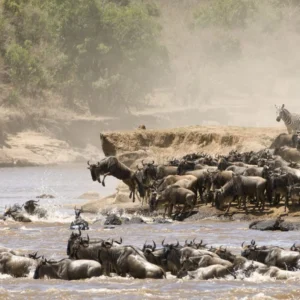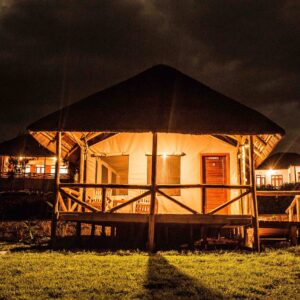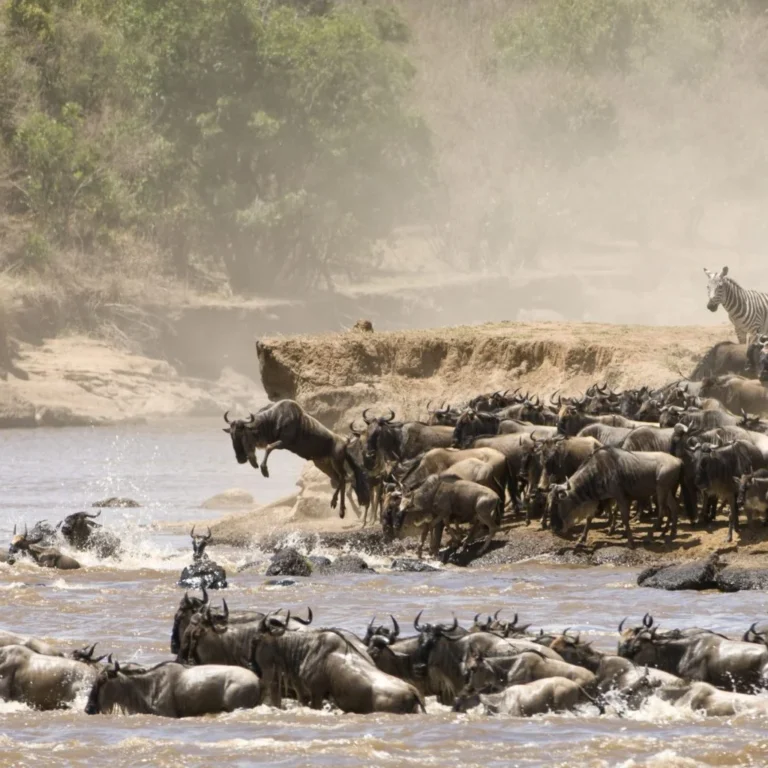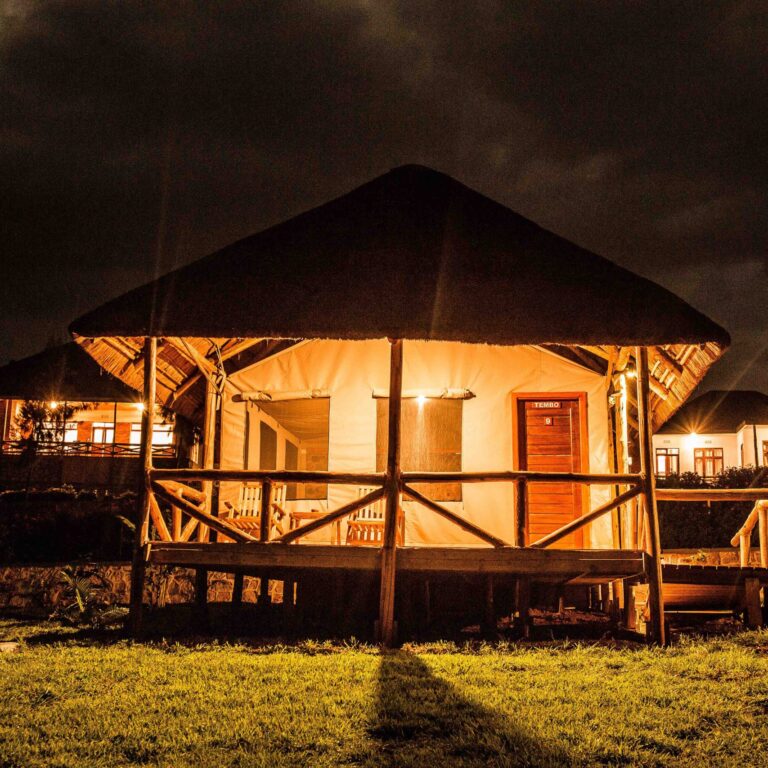In a world increasingly connected, the allure of true wilderness, the most remote places in Africa worth visiting, of places where the rhythm of nature dictates the day and human footprints are few and far between, remains powerfully magnetic. Africa, with its vast savannas, ancient forests, and dramatic geological formations. Holds some of the planet’s last genuinely remote sanctuaries. These aren’t just destinations; they are experiences, journeys into the untamed heart of the continent where wildlife thrives, and solitude is a treasured commodity. Some of the most remote and unique places to visit in Africa include the Usangu Game Reserve in Tanzania. Gabon’s Lopé National Park, the Simien Mountains in Ethiopia, the Skeleton Coast in Namibia, and the Danakil Depression in Ethiopia. These locations offer a mix of pristine wilderness, unique ecosystems, and undisturbed wildlife encounters.
While some of Africa’s iconic parks draw large crowds, there are still vast expanses where the whisper of the wind. The distant roar of a lion and the rustle of unseen creatures are your only companions. These remote havens offer a profound connection to nature. An immersive experience far removed from the everyday. This guide delves into some of Africa’s most remote and immensely rewarding places. Inviting you to step off the beaten path and discover the continent’s wild, untamed soul.
1. Ruaha National Park, Tanzania: The Wild Heart of the South
Why it’s Remote. Located in Tanzania’s southern circuit, Ruaha is Tanzania’s largest national park. Yet it receives significantly fewer visitors than its northern counterparts the best Isolated Lodges in Africa. Its sheer size (over 20,000 sq km / 7,700 sq mi) means you can drive for hours without seeing another vehicle. Offering an unparalleled sense of wilderness and exclusivity. Access is typically by scheduled light aircraft flights.
Why it’s Worth Visiting. Ruaha is a true wilderness giant, where the dry, rugged landscape is dominated by the majestic Ruaha River. This river is the park’s lifeline, especially during the dry season, when it becomes a magnet for colossal herds of elephants (Tanzania’s largest population). Huge buffalo gatherings, and an astonishing diversity of antelopes, including the rare Greater Kudu and Sable Antelope. Ruaha is also renowned for its very large lion prides. Often numbering over 20 individuals, and excellent leopard and cheetah sightings. The convergence of different vegetation zones (Acacia savanna, miombo woodlands, riverine forest) results in a unique mix of East and Southern African wildlife.
2. Mikumi National Park, Tanzania: The Accessible Wilderness
Why it’s Remote (in Context). While more accessible by road from Dar es Salaam than many southern parks. Mikumi still offers a taste of Tanzania’s wild south without the bustling crowds of the northern circuit. Its proximity to the main highway means it’s often overlooked by those seeking extreme remoteness, but it provides a convenient and authentic safari experience that feels far removed from urban life.
Why it’s Worth Visiting. Mikumi’s landscape is often compared to the Serengeti, with vast open floodplains (the Mkata Floodplain) dotted with acacia trees. It offers excellent year-round wildlife viewing, with large populations of buffalo, wildebeest, zebra, impala, and giraffe. Elephant and lion sightings are common, and the park boasts over 400 bird species. The hippo pools are a highlight, providing close-up views of these fascinating semi-aquatic giants. Its accessibility makes it an ideal choice for shorter safaris or as a starting point for exploring the deeper south.
3. Nyerere National Park (formerly Selous Game Reserve), Tanzania: Africa’s Largest Wilderness
Why it’s Remote: Encompassing the northern part of the vast Selous Game Reserve, Nyerere National Park is Africa’s largest protected area, covering over 30,893 sq km (11,928 sq mi), the remote places in Africa for Authentic, Off-the-Grid Travel. Its sheer scale and limited road infrastructure (fly-in safaris are common) ensure an exceptionally wild and uncrowded safari experience. It’s a place where you can immerse yourself deeply in the bush.
Why it’s Worth Visiting. Nyerere offers a diverse range of safari activities beyond traditional game drives to remote and luxurious places to stay in Africa. Its lifeline, the mighty Rufiji River, provides incredible boat safaris, allowing you to see hippos, crocodiles, and abundant water birds from a unique perspective. Walking safaris are also a highlight, offering an intimate connection with the environment. The park is renowned for its significant populations of elephants, buffalo, and a healthy number of African Wild Dogs, one of the continent’s most endangered predators. The untouched ecology and vastness provide a sense of timeless Africa.
4. Serengeti National Park (Remote Zones), Tanzania: Beyond the Crowds
Why it’s Remote. While the central Serengeti (Seronera) can be busy, the park’s immense size (14,763 sq km / 5,700 sq mi) means vast areas offer true solitude, Africa’s most amazing places to visit.
Western Corridor. Especially during the Great Migration’s Grumeti River crossings (June-July), this area offers thrilling, less crowded sightings than the Mara River.
Northern Serengeti (Kogatende/Lamai). Even during the peak Mara River crossings (August-October), this vast northern expanse can offer pockets of solitude if you stay in mobile camps strategically located away from the main crossing points.
Mobile Camps. Opting for truly mobile tented camps that move with the migration (rather than fixed lodges) provides an intensely immersive and often exclusive experience, following the herds to less accessible regions.
Why it’s Worth Visiting. The Serengeti is globally famous for the Great Wildebeest Migration, a spectacle of over 2 million animals. Beyond the migration, it offers phenomenal year-round game viewing, including the Big Five (lion, leopard, elephant, buffalo, rhino – though rhino sightings are more consistent in Ngorongoro). Its endless plains, kopjes (rocky outcrops), and riverine forests create diverse habitats for an incredible array of wildlife and birdlife.
5. Katavi National Park, Tanzania: The Untamed Frontier
Why it’s Remote. Nestled in western Tanzania, Katavi is one of Africa’s most pristine and least-visited wildernesses perfect African safari destinations for your trip. Its extreme remoteness, primarily accessible by costly charter flights, means it offers an unadulterated safari experience that feels like stepping back in time. This is truly off-the-beaten-path.
Why it’s Worth Visiting. Katavi is renowned for its vast, untouched landscapes of floodplains, woodlands, and the seasonal Katuma River. During the dry season (June-October), the river and remaining waterholes become incredible concentrations of wildlife. Katavi is famous for its massive hippo pods (hundreds can be crammed into dwindling pools) and incredible numbers of crocodiles. It also boasts some of the largest buffalo herds on the continent, excellent lion and leopard sightings, and a healthy population of African Wild Dogs. It’s a raw, visceral safari where the drama of survival unfolds daily.
6. Mahale Mountains National Park, Tanzania: Chimpanzees by the Lake
Why it’s Remote. Located on the pristine white sand shores of Lake Tanganyika in western Tanzania. Mahale is incredibly remote, accessible almost exclusively by light aircraft flights and then by boat across the lake. There are very few camps, ensuring an intimate and exclusive experience.
Why it’s Worth Visiting. Mahale is one of the premier destinations in Africa for chimpanzee trekking. Home to a large, habituated population of chimpanzees, trekking into the lush mountain forest to spend time with our closest relatives in their natural habitat is a profoundly moving experience. Beyond chimps, the park offers stunning scenery, excellent birdwatching, and the opportunity for leisurely swims, snorkeling, and fishing in the crystal-clear waters of Lake Tanganyika – a unique combination of forest and beach.
7. Gombe Stream National Park, Tanzania: Goodall’s Legacy
Why it’s Remote. Tanzania’s smallest national park, Gombe Stream, is nestled along the eastern shore of Lake Tanganyika. Accessible only by boat from the town of Kigoma. Its isolated location and focus on a single, primary activity contribute to its remote feel, though it’s relatively well-known due to its history.
Why it’s Worth Visiting. Gombe is famous as the site of Dr. Jane Goodall’s groundbreaking chimpanzee research. Trekking into the dense forest to observe the habituated chimpanzees is the main draw. Offering a chance to witness their complex social behaviors firsthand. The park also features other primates, diverse birdlife, and the beautiful backdrop of Lake Tanganyika, making it a unique and historically significant wildlife encounter.
8. Saadani National Park, Tanzania: Where the Bush Meets the Beach
Why it’s Remote. Saadani National Park is unique as Tanzania’s only coastal national park, where the bush meets the beach. While not as logistically challenging to reach as some other remote parks (it’s accessible by road or short flight from Dar es Salaam). Its “off the main circuit” location and relatively low visitor numbers give it a distinct remote charm.
Why it’s Worth Visiting. Saadani offers an unparalleled combination: you can enjoy a morning game drive and spot elephants, giraffes, or lions, then relax on pristine Indian Ocean beaches in the afternoon. Boat safaris on the Wami River are a highlight, providing opportunities to see hippos, crocodiles, and diverse birdlife, often alongside elephants coming to drink. It’s one of the few places where you might see elephants strolling on the beach. Its unique blend of terrestrial and marine ecosystems makes it a truly special and tranquil safari destination.
9. Ngorongoro Conservation Area (Highlands), Tanzania: Beyond the Crater Floor
Why it’s Remote (within a popular area): While the Ngorongoro Crater floor is justly famous and can be busy, the broader Ngorongoro Conservation Area (NCA) is vast and offers incredibly remote and exclusive experiences.
Highlands Walking Safaris. Away from the crater, the Ngorongoro Highlands allow for guided walking safaris into pristine volcanic landscapes and forests. These are often multi-day treks through stunning scenery, allowing for an immersive experience without vehicles.
Empakaai Crater. Trekking to the lesser-visited Empakaai Crater, with its stunning views and flamingo-filled soda lake, offers a sense of solitude absent from its famous neighbor.
Why it’s Worth Visiting. The NCA is a UNESCO World Heritage site, offering incredible biodiversity most remote places in Africa worth visiting. Beyond the world-renowned Ngorongoro Crater (a guaranteed Big Five sighting location). The highlands provide dramatic scenery, unique Maasai cultural interactions, and a chance to experience the stunning natural beauty on foot, far from the tourist crowds.
10. Tarangire National Park, Tanzania: The Land of Giants (and Solitude)
Why it’s Remote (within a popular circuit). Tarangire is part of Tanzania’s northern safari circuit, but its immense size (over 2,850 sq km / 1,100 sq mi) and strategic placement of some lodges mean that it’s possible to find genuine solitude, especially in its less-frequented southern and eastern regions
Why it’s Worth Visiting. Tarangire is particularly famous for its enormous herds of elephants, often numbering in the hundreds, especially during the dry season when they congregate along the Tarangire River. It’s a land of majestic baobab trees, which create a unique and highly photogenic landscape. The park also boasts a good population of lions (including tree-climbing lions), leopards, cheetahs, and a wide array of plains game. Its diverse habitats make it an excellent birdwatching destination. For those seeking quiet corners within a popular region, Tarangire delivers.
11. Lake Natron and Mount Oldonyo Lengai, Tanzania: An Otherworldly Landscape
Why it’s Remote. Located in the remote northern Rift Valley, near the Kenyan border, Lake Natron and the active volcano Ol Doinyo Lengai are far off the typical northern safari route. Access roads can be challenging, particularly in the wet season, and the region has limited infrastructure, contributing to its untouched feel.
Why it’s Worth Visiting. This area offers a starkly beautiful, almost otherworldly landscape.
Lake Natron. A highly alkaline “soda lake” that turns a vivid red or pink due to microorganisms most remote places in Africa worth visiting.
Venturing to Africa’s remote places is not merely a vacation. It’s an expedition, a challenge, and a profound privilege most remote places in Africa worth visiting. These destinations offer a chance to disconnect from the modern world and reconnect with nature on a fundamental level. From witnessing the sheer scale of untouched ecosystems to intimate encounters with rare and magnificent creatures. These untamed corners of Tanzania promise a safari experience unlike any other – a journey into the very heart of the wild. Leaving you with memories that will resonate for a lifetime. It’s the primary breeding ground for East Africa’s Lesser Flamingos. Creating a breathtaking spectacle.
Ol Doinyo Lengai. Known as the “Mountain of God” to the Maasai, this is Africa’s only active carbonatite volcano, extruding unique, dark, flowing lava. Trekking to its summit (often a challenging overnight climb for sunrise views). An incredible adventure, offering panoramic views of the Rift Valley and the reddish lake below. The area also provides authentic Maasai cultural encounters and opportunities for unique walking safaris to waterfalls and gorges.
- Is the Ngorongoro Crater Worth Visiting?
- The Allure of Climbing Kilimanjaro: Is It Worth the Challenge?
- Is Mount Meru Worth Climbing?
- A Complete Guide To Walking Safari in Tanzania: Embark on an Unforgettable Adventure
- 8 Common Challenges of Remote Working While Traveling
- 15 Things You Need to Know Before Visiting Tanzania






